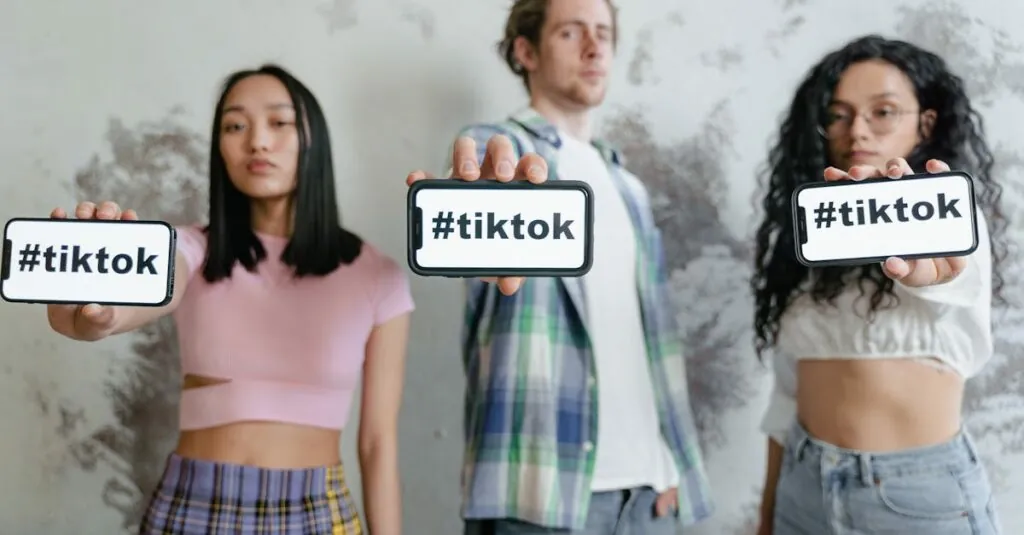In today’s digital playground, viral culture reigns supreme. It’s that wild, unpredictable phenomenon where memes, challenges, and trends explode overnight, leaving everyone scrambling to catch up. One minute, a cat video is making the rounds, and the next, people are dancing in their living rooms to the latest TikTok craze. It’s a whirlwind of creativity and chaos that keeps us all glued to our screens.
But what makes something go viral? Is it sheer luck, or is there a secret recipe behind those catchy hashtags and irresistible visuals? Understanding viral culture isn’t just for social media gurus; it’s for anyone who wants to stay relevant in this fast-paced world. Dive into the quirky and fascinating realm of viral culture, where trends come and go faster than you can say “viral sensation.” Get ready to explore how this phenomenon shapes our conversations, influences our choices, and keeps us all entertained.
Table of Contents
ToggleUnderstanding Viral Culture
Viral culture represents the dynamics of information spread in the digital age. It involves memes, trends, and challenges capturing widespread attention rapidly.
Definition and Explanation
Viral culture refers to content that spreads rapidly online, resonating with large audiences. Memes and trends gain traction through social media platforms, fostering engagement. Often, this content reflects cultural moments, influencing personal and collective identities. Viewers share compelling content, creating an exponential expansion of reach. Emotional resonance and relatability drive this phenomenon, showcasing humanity’s connection through shared experiences.
Historical Context
The origins of viral culture trace back to early internet memes in the late 1990s. Platforms like forums and chatrooms facilitated content sharing, introducing concepts like “All Your Base Are Belong to Us.” With the rise of social media in the mid-2000s, rapid dissemination accelerated. YouTube popularized video content, leading to iconic viral moments, such as the “Charlie Bit My Finger” clip in 2007. Later, apps like TikTok reignited interest with brief, engaging videos, demonstrating the evolving nature of viral culture.
Importance of Viral Culture
Viral culture plays a significant role in shaping modern interactions and trends across various fields. Its influence extends beyond entertainment, impacting sectors like medicine and research.
Contributions to Medicine
Memes and viral challenges often raise awareness for critical health issues. Campaigns using hashtags connect with millions, spreading important health information quickly. This rapid dissemination has increased participation in health-related initiatives, such as vaccination drives. For instance, social media platforms leveraged viral content to promote mental health awareness, encouraging conversations that reduce stigma. Engaging content can boost funding for medical research by reaching wider audiences and generating interest. In COVID-19 communication, viral videos helped convey crucial safety measures, reinforcing public health messaging.
Impacts on Research
Viral culture encourages collaboration among researchers by fostering connections through social media. Scholars share their findings widely, which keeps their work relevant and accessible. Platforms like Twitter allow researchers to engage with the public, sparking discussions that can lead to future studies. By participating in trending topics, researchers can secure funding and attract attention to their projects. Additionally, open data initiatives often gain traction through viral sharing, leading to innovative applications and interdisciplinary research. Viral culture ultimately shapes research priorities, guiding scientists to focus on topics that resonate with society.
Methods of Cultivating Viruses
Cultivating viruses involves careful methodologies and stringent safety practices. Understanding these methods ensures effective research outcomes and public health safety.
Laboratory Techniques
Isolation techniques allow researchers to obtain viruses from varied sources, including infected tissues or environmental samples. Propagation methods include using cell cultures, which provide a controlled environment for viral growth. Moreover, assays determine viral presence and quantify viral loads, contributing to monitoring the spread of infectious agents. Advanced techniques like reverse transcription polymerase chain reaction (RT-PCR) offer precise analysis of viral RNA, enhancing detection efficiency. Moreover, genetic sequencing helps researchers trace viral evolution, facilitating responses to emerging threats. Utilizing these techniques, scientists can effectively study virus behavior, leading to new insights in virology.
Safety Considerations
Safety considerations play a crucial role in laboratory settings focused on viral cultivation. Strict biosafety levels (BSL) dictate protocols based on the virus’s risk level, ensuring appropriate containment measures. Personal protective equipment (PPE), including gloves and masks, minimizes exposure risks to researchers. Moreover, proper waste disposal methods prevent environmental contamination from viral materials. Additionally, training staff on emergency response plans enhances preparedness in the event of accidental exposure or escape. Regular audits and inspections maintain compliance with safety regulations, promoting a secure research environment. Prioritizing these considerations ensures that viral research advances while safeguarding human health.
Applications of Viral Culture
Viral culture plays a vital role in various scientific applications, especially in health and research fields.
Vaccine Development
Viral culture is essential for developing vaccines. Researchers utilize cultured viruses to produce antigens, which stimulate immune responses. Techniques involve growing viruses in specific cell lines to ensure effectiveness. Studies show that vaccines derived from viral cultures result in higher efficacy rates, providing robust protection against diseases. For example, the influenza vaccine relies on viral culture to produce specific strains. This methodology allows for rapid adaptation to evolving viruses, maintaining public health safety.
Disease Surveillance
Viral culture significantly aids disease surveillance. It helps track the spread of infections by analyzing samples from affected individuals. Experts isolate and propagate viruses from these samples to monitor mutations and resistance patterns. This process enables public health officials to identify outbreaks and implement necessary interventions promptly. Additionally, it allows for real-time monitoring of viral loads in populations, facilitating timely responses to emerging threats. Moreover, data obtained from viral cultures informs epidemiological studies, thereby enhancing overall disease control strategies.
Challenges and Controversies
Viral culture presents multiple challenges and controversies that warrant discussion. The rapid dissemination of content raises significant ethical concerns, particularly regarding consent and ownership. Content creators often utilize images or video snippets without permission, creating potential copyright infringements. The issue of sensationalism also arises, as viral trends can sometimes prioritize shock value over accuracy, spreading misinformation quickly. Engaging in this behavior can lead to significant impacts on public discourse and trust.
Technical limitations also hinder the understanding of viral culture. Algorithms drive engagement on platforms, but their opaqueness often skews the content that gains visibility. Research into viral trends frequently encounters constraints, such as a lack of comprehensive data on user behavior. Tools to analyze the true impact of viral content often fall short, particularly when measuring emotional resonance or long-term engagement. Consequently, these limitations impede the ability to fully grasp how viral trends shape cultural dynamics.
Viral culture continues to shape the digital landscape in profound ways. Its influence reaches far beyond entertainment, impacting critical areas like health awareness and scientific research. As trends evolve and platforms adapt, understanding the dynamics of viral culture becomes essential for anyone navigating this fast-paced environment.
The challenges and ethical considerations surrounding viral content highlight the need for responsible engagement and awareness. As society embraces these rapid shifts, the interplay between creativity and accountability will define the future of viral culture. Embracing this dynamic can lead to innovative opportunities while fostering informed conversations that resonate with audiences worldwide.



